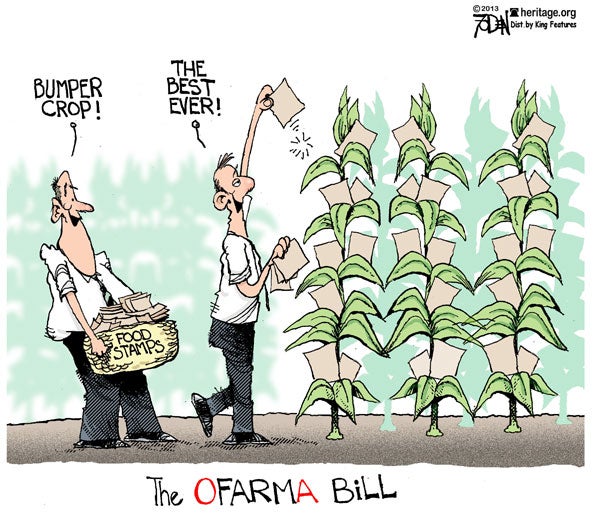Morning Bell: A Bumper Crop of Food Stamps
Amy Payne /
Where do food stamps come from?
They come from taxpayers—certainly not from family farms. Yet the “farm” bill, a recurring subsidy-fest in Congress, is actually 80 percent food stamps and other government nutrition programs.
The food stamps sweeten the farm deal for lawmakers, who admit that the combination works for their political purposes. As Heritage experts Daren Bakst and Diane Katz explain:
The food stamp portion creates a reason for urban representatives to support farm subsidies, and for farm-state lawmakers to support food stamps.
Talk of de-politicizing agriculture programs and welfare policy is met with stiff resistance. For example, Senator Thad Cochran (R–MS), ranking Republican on the Senate Agriculture Committee, recently told the North American Agricultural Journalists group that food stamps should continue to be included in the farm bill “purely from a political perspective. It helps get the farm bill passed.”
Food stamps are there to help “get the farm bill passed.” And the relation of the rest of the farm bill to farming is also questionable. Bakst and Katz note that “Congress has expanded the farm bill over time into a costly compilation of disparate programs. Along with agriculture and food stamps, the legislation includes dozens of forestry, conservation, energy, and rural development programs.”
It has become the norm that Congress lumps billions—even trillions—of dollars in taxpayer-funded programs together into huge bills. This allows them to sneak in plenty of special-interest pork.
Each of these programs deserves to be evaluated on its own, and taxpayers deserve transparency from Congress about how it plans to spend our money.
For example, food stamps are a massive program that needs a careful look. Food stamp spending has doubled under the Obama Administration, and participation is at historic highs. Recruiters hold bingo games and other “parties” to try to get more people on the food stamp rolls.
Farm commodity programs are also a major concern and in dire need of reform. Congress may eliminate the egregious direct payment program, which pays farmers for doing nothing. However, instead of stopping there, both the House and Senate farm bills would replace direct payments with programs that could wind up being even costlier.
Food stamps and farming ultimately have to do with food, but that’s about all they have in common. Making the farm bill 80 percent food stamps just doesn’t make sense.
LEARN MORE:
Fact Sheet >> Farm Bill: Ripe for Reform
Read the Morning Bell and more en español every day at Heritage Libertad.
Quick Hits:
- Moore, Oklahoma, was devastated by a tornado yesterday that killed at least 91 people and injured hundreds more.
- The labor union representing those who approve immigration applications is speaking out against the Gang of Eight immigration bill, saying it would make the current system “worse.”
- The U.S. has announced it will sign the U.N.’s Arms Trade Treaty. Heritage’s Ted Bromund explains why this would be a terrible decision.
- A high school senior has invented a device that can charge a cell phone in 20 to 30 seconds.
- Are you a veteran looking for a community? Or are you looking for a way to thank our veterans? Here are some places you can get plugged in.

